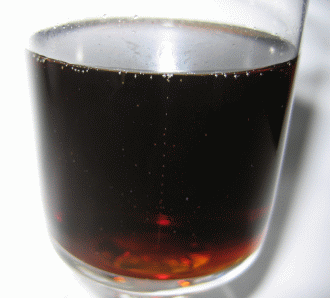Bubbles in a soft drink (Part I)
Bubbles in a soft drink (Part I)
LEE Boon-ying
What causes the hissing sound when a bottle of soft drink is opened?
A soft drink contains dissolved carbon dioxide. The space above the soft drink is filled with carbon dioxide at more than twice the atmospheric pressure. The hissing sound results from the escape of the gas into air.
Why are there bubbles?
When a bottle is opened the pressure inside decreases. Bubbles appear as the carbon dioxide dissolved in the liquid turns into gas.
If you look closely at a glass of soft drink, the bubbles seem to come out from a number of definite spots. Why is that?
The definite spots may be: (a) small cracks in the glass; or (b) impurities on the side of the glass or inside the drink. These spots are often pitted and cracked, and have many sites, called nucleation sites, where bubbles easily grow.

Apart from the sites above, the bubbles do not form anywhere else. Why is that?
A bubble consists of gas surrounded by liquid. Thus a surface exists which separates the gas and the liquid. It takes energy to form a surface (Remember the term 'surface energy' when you experiment with soap bubbles?). For example, when you break a piece of chalk two new surfaces are created, and this takes energy even though the required energy is not much. Nucleation sites facilitate the growth of bubbles.
Where else could I observe the phenomenon of nucleation?
In clouds. Clouds would not normally form unless there is dust or tiny particles in the atmosphere. A cloud is like the bubbles in a soft drink, but in reverse. A cloud is made up of small water droplets in air, whereas the bubbles are just gas droplets in a liquid. Both water droplets and bubbles require nucleation sites to form.
You can also observe it in a cloud chamber in the laboratory. Here water droplets are formed around ions (which act as nucleation centres) produced during the passage of ionizing agents such as alpha-, beta-particles or gamma-rays. Cloud chambers are used for studying radioactivity.
Can you think of another example of nucleation? Please write to us at: train1@hko.gov.hk.
Look closely at a glass of soft drink. Are the bubbles all of the same size? Are they evenly spaced apart?
No. You can easily see that they are not all of the same size and are not evenly spaced apart. You can see that the spacing between bubbles increases more or less steadily with distance from the formation point. Also, the bubbles generally grow as they rise. Can you explain these? Write to us at train1@hko.gov.hk.
Exercise
Sprinkle some salt into the soft drink. What do you see? What has this to do with the discussion above?
Reference:
[1] 'Clouds in a glass of beer', C.F. Bohren, Dover Publications, Inc. 1987
[1] 'Clouds in a glass of beer', C.F. Bohren, Dover Publications, Inc. 1987